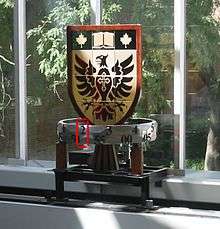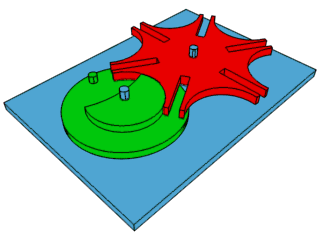Iron Ring Clock
The Iron Ring Clock is a clock of unusual design created by four Mechanical Engineering students at McMaster University in Hamilton, Ontario, Canada. The clock was designed and built as a thesis project by Patrick Burton, Braden Kurczak, Michael Paddags, and Peter Whitred. It won the 2nd prize for Manufacturing at the 2003 Canadian Society for Mechanical Engineering Student Design Competition. The clock was simultaneously put into commission and donated to McMaster University in September 2003. The design is based on the iron ring worn by many Canadian engineers.

The clock was designed in large part in a four-month period at the end of 2002, with some features that were originally intended for an outdoor installation. The clock keeps time through the use of a synchronous alternating current motor, which regulates its speed based on the frequency of the electricity that it is fed. The top and bottom halves of the ring can rotate independently, with the top half of the ring displaying the hours, and the bottom half the minutes. The minute ring moves constantly, while the hour ring increments once an hour through the use of a Geneva drive mechanism. The rings are driven through a gearbox that was designed and partly manufactured by the group. The two ring sections are made of forged stainless steel, with machined surfaces, and facets cut using a robotic six-axis water jet cutter. The central shield, which is the university coat of arms, is made of hand-crafted stained glass. The design of the clock was completed entirely with computer-aided design software, and CNC tools were used for components where the most precision was required. Although the clock was donated to McMaster University on completion, it is maintained by members of the team that built it.
To minimise costs, the team with help from technicians manufactured as many components as possible in an on-campus machine shop. The total cost of the clock was approximately $20,000 CAD, which was raised through donations, with donors listed on a nearby plaque.
The team believes that the iron ring made for the project, with a diameter slightly greater than 1 metre, is the largest in the world.
Issues and lifetime wear

While it is quite well known on campus,[1] the Iron Ring Clock is not always recognized as a clock. The most common criticism of the clock is that it is counterintuitive to read. (It must be read straight on, with the number on the top ring denoting the hour and the number on the bottom ring denoting the minute. If there is no number directly under the hour indicator, the minute must be inferred from the nearest two numbers.) As the rings move slowly, the clock has been mistaken for a static display. It has shown the wrong time in the past, due to events such as power outages or breakdowns; in 2006/2007, the clock stopped for three months due to motor bearing failure. In 2007, an uninterruptible power supply was installed to eliminate the problem with power outages. However, in the absence of such events the motor and mechanism have shown themselves to be quite accurate.
The clock has also had issues with mechanical wear; the use of steel ball bearings to support and position the rings has led to grooves being worn into the rings themselves, as the bearings are hardened steel and the rings are not. Some of these bearings have been replaced, as it becomes necessary; the group is considering future solutions to this problem. Other portions of the gear train are mounted on bronze bearings; these are expected to have a shorter wear life and will likely have to be replaced sooner than other gearbox components.
The Geneva wheel, made of aluminum for ease of manufacture, has also experienced some wear and will eventually need to be remade (the mechanism used in the clock differs slightly from the one shown in the graphic as it has only four spokes) .
References
- Notes
- Julia Thomson (2005-10-28). "75 people, places and things". McMaster Daily News. McMaster University Office of Public Relations. Archived from the original on 2011-07-27.
- Bibliography
- Peter Van Harten (2003-03-01). "A Brief History of Mac Time". The Hamilton Spectator.
- Peter Van Harten (2003-09-06). "Engineering prank earns passing grade". The Hamilton Spectator.
- Torstar News Service (September 8, 2003). "Time piece becomes legacy". Toronto Metro.
- "Students give gift of time" (PDF). MacEngineer. McMaster University. 28 (1): 15. Spring 2003. Archived from the original (PDF) on 2011-07-17.
- "Engineering Graduates Leave Distinctive Legacy" (PDF). MacEngineer. McMaster University. 29 (1): 19. Winter 2004. Archived from the original (PDF) on 2011-07-17.